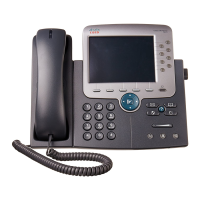Usage notesPurposeNetwork protocol
The Cisco Unified IP Phone supports
LLDP-MED on the SW port to
communicate information such as:
•
Voice VLAN configuration
•
Device discovery
•
Power management
•
Inventory management
For more information about LLDP-MED
support, see the LLDP-MED and Cisco
Discovery Protocol white paper:
http://www.cisco.com/en/US/tech/tk652/
tk701/technologies_white_
paper0900aecd804cd46d.shtml
LLDP-MED is an extension of the
LLDP standard developed for voice
products.
Link Layer Discovery
Protocol-Media Endpoint
Devices (LLDP-MED)
RTCP is disabled by default, but you can
enable it on a per-phone basis in Cisco
Unified Communications Manager
Administration. For more information,
see Network Configuration Menu, on
page 103.
RTCP works with Real-Time
Transport Protocol (RTP) to provide
QoS data (such as jitter, latency, and
round trip delay) on RTP streams.
Real-Time Control
Protocol (RTCP)
Cisco Unified IP Phones use the RTP
protocol to send and receive real-time
voice traffic from other phones and
gateways.
RTP is a standard protocol for
transport of real-time data, such as
interactive voice and video, over data
networks.
Real-Time Transport
Protocol (RTP)
Like other VoIP protocols, SIP addresses
the functions of signaling and session
management within a packet telephony
network. Signaling allows call
information to be carried across network
boundaries. Session management
provides the ability to control the
attributes of an end-to-end call.
You can configure the Cisco Unified IP
Phone to use either SIP or Skinny Client
Control Protocol (SCCP).
Cisco Unified IP Phones do not support
the SIP protocol when the phones
operate in IPv6 address mode.
SIP is the Internet Engineering Task
Force (IETF) standard for multimedia
conferencing over IP. SIP is an
ASCII-based application-layer control
protocol (defined in RFC 3261) that
can establish, maintain, and terminate
calls between two or more endpoints.
Session Initiation Protocol
(SIP)
Cisco Unified IP Phone 7975G, 7971G-GE, 7970G, 7965G, and 7945G Administration Guide for Cisco Unified
Communications Manager 9.0 (SCCP and SIP)
9
Cisco Unified IP Phone
Network Protocols

